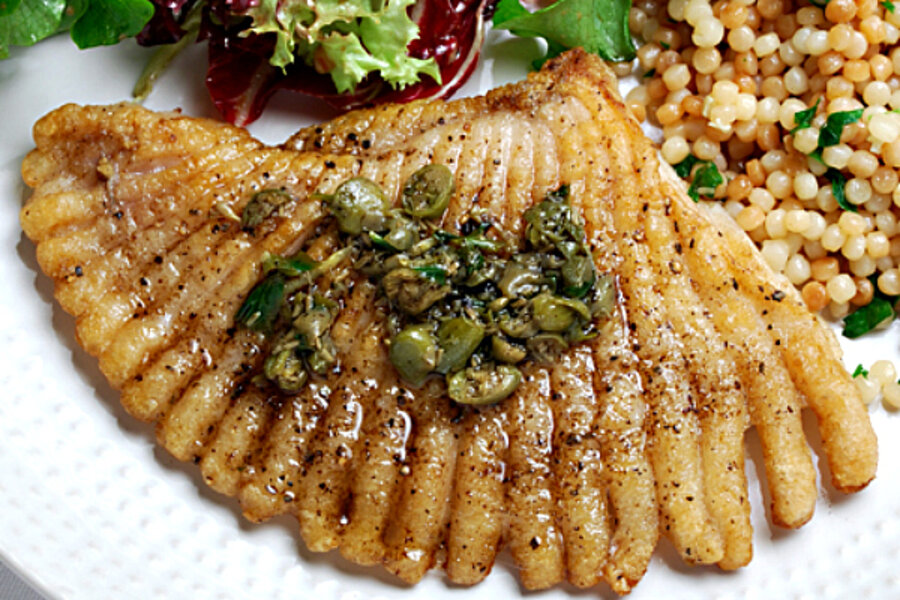The other white fish: skate
Loading...
Are you English?” The question surprised me. I answered with a simple no. “Well, did you live in England for a while?” Again, no. I was curious as to what had the fishmonger at Dirk’s Fish & Gourmet Shop convinced that I had some English connection. Turns out it was the pound or so of skate wing fillet he’d just wrapped up for me.
Long considered a trash fish, skate has grown in popularity in recent years. But it’s been quite popular in the UK for some time. In fact, Marion remembers being in a restaurant in Paris with her sister that had skate on the menu one evening several years ago. The only people ordering it were visiting Brits.
Skate is a deliciously mild, slightly sweet fish that isn’t at all fishy. And its muscle structure makes for a beautifully exotic presentation on the plate, as you can see above.
Skates are cartilaginous fish – their skeletons are made of cartilage, rather than bone. They’re related to rays, which they closely resemble, and sharks. Skates are kite-shaped flat fish with large wings; these wings are the edible part.
Thinking of Marion’s Paris experience – and, having recently watched "Julie & Julia" again, of Julia’s life-changing moment when she tasted sole meunière on her first day in France with Paul – I decided I would use this simple, classic French preparation for the skate.
Except, as with all “classics,” there were countless variations on the theme. Thyme, broth, wine and even heavy cream were mentioned in various recipes I came across. So I went with the constants I found – lemon juice [and the zest – I can rarely pass up lemon zest in any recipe involving lemon juice], parsley and lots of butter. Flour is another constant, a given, in fact. According to Food & Wine, “Meunière means miller’s wife and refers to the dusting of flour on the fish.” And then I threw in another bit of bright tartness, capers.
If you can’t find skate wing fillets, other white-fleshed fish – sole, flounder, halibut or ocean perch, for instance – may also be used. But besides the mild, sweet flavor that makes seeking out skate worthwhile, it’s not as insanely fragile as some white-fleshed fish, sole in particular. It held together nicely, even after it was cooked on both sides. And still, it was delicate enough to be cut with a fork. Regarding its non-fishy mildness, when we came home to our closed up apartment the next day after running errands, there was no lingering fish smell at all. However, the kitchen still smelled of butter!
If you do find skate, make sure it has already been filleted. Dealing with countless pieces of cartilage in non-filleted pieces of skate can be a real pain.
Skate Meunière with Browned Butter and Capers
Serves 4
2 skate fillets, about 1 pound or a little more total
Salt and freshly ground pepper, to taste
Flour
2 tablespoons canola oil, divided
5 to 6 tablespoons unsalted butter, divided
Juice and zest of 1 lemon
2 tablespoons capers, chopped
1 generous tablespoon chopped flat parsley
Preheat oven to 200 degrees F. Cut skate fillets into 2 equal pieces. Season with salt and pepper on one side. Dredge in flour on both sides, shaking off excess.
Heat a large nonstick skillet over medium flame. Add 1 tablespoon each of oil and butter, swirling to mix as butter melts. Place 2 skate fillets in pan, seasoned side down. Sauté for about 3 minutes, then carefully turn with a wide spatula. Cook on second side until just cooked through, 2 to 3 minutes. Transfer fillets to plate and keep warm in oven while you cook the remaining two fillets, first adding more oil and butter to skillet, if necessary. Transfer second batch of fillets to oven too.
Wipe skillet clean and return to flame. Melt remaining 4 tablespoons of butter in skillet. Cook, occasionally stirring, until butter browns, 3 to 4 minutes. Meanwhile, plate skate fillets. Add lemon juice, zest, capers and parsley to skillet, stirring. The lemon juice will make the pan spatter like crazy. That’s okay. Just be careful. Turn off the heat and spoon sauce over fillets. Serve immediately.
Related post: Ten favorite recipes from five years of writing Blue Kitchen





